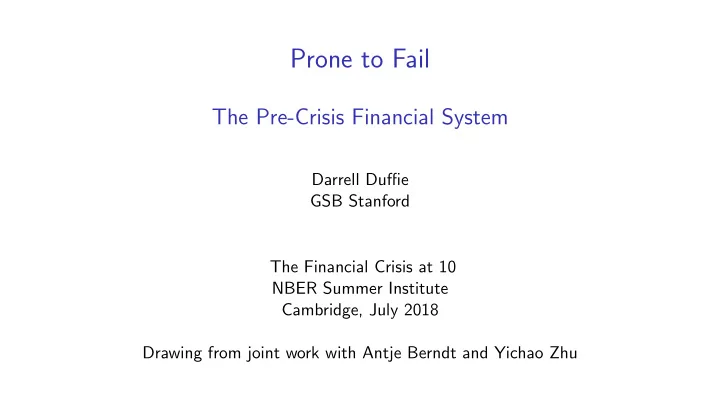

Prone to Fail The Pre-Crisis Financial System Darrell Duffie GSB Stanford The Financial Crisis at 10 NBER Summer Institute Cambridge, July 2018 Drawing from joint work with Antje Berndt and Yichao Zhu
Average leverage of systemic banks and investment banks 40 I-banks: GS-MS-LEH-BSC-MER Banks: C-BAC-JPM*-WFC 35 30 25 Leverage 20 15 10 5 0 1998 2000 2002 2004 2006 2008 2010 2012 2014 2016 Data source: 10K filings. J.P. Morgan includes preceding mergers, pro forma.
Pre-crisis big-bank credit spreads were tiny 250 200 LBOR-OIS spread (basis points) 150 100 50 0 2002 2004 2006 2008 2010 2012 2014 2016 2018 One-year USD LIBOR-OIS spread. Data source: Bloomberg.
Big-bank pre-crisis asset growth 11 JPM*-BAC-C-WFC 10 GS-MS-MER-LEH-BSC 9 8 Total assets (trillions of dollars) 7 6 5 4 3 2 1 0 1998 2000 2002 2004 2006 2008 2010 2012 2014 2016 2018 Total assets of nine bank and I-bank holding companies. Data source: 10K filings.
Pre-crisis conditions were set for an unstable core financial system big banks vulnerable yes to shocks regulators market creditors supervise discipline believe in yes weakly? fails bailouts?
What were they thinking ? Potential explanations: 1. Irrationally low belief in disaster scenarios (Gennaioli and Shleifer, 2018). 2. Fragile by design (Calomiris and Haber, 2014). 3. Dogmatic reliance on market discipline (Greenspan, 1997). 4. It was too difficult, within reason, for regulators to detect the problems. 5. Failure to assign regulators a clearer financial-stability mandate (Kohn, 2014).
Investment banks’ net capital in 2005, versus SEC required net capital 5 Net capital 4.5 Early warning requirement Required net capital 4 3.5 Net capital ($ billions) 3 2.5 2 1.5 1 0.5 0 MS LEH BSC MER GS Data source: 10K filings.
Heavy U.S. dependence on credit supplied through bond markets 80% China UK 70% Japan US Eurozone 60% Credit provided via capital markets 50% 40% 30% 20% 10% 0 1985 1990 1995 2000 2005 2010 2015 Data source: Bank for International Settlements.
Look for short-term debt in the core of the financial system “Private financial crises are everywhere and always due to problems of short-term debt.” – Douglas Diamond (2013)
Pre-crisis buildup of primary dealers’ short-term repo financing 3 overnight and continuing term 2.5 Repos outstanding (trillions of dollars) 2 1.5 1 0.5 0 2002 2004 2006 2008 2010 2012 Rolling quarterly average of repos of primary dealers. Data source: Federal Reserve Bank of New York.
Pre-crisis securities financing in U.S. money markets Fed retail banks major dealers cash pools other dealers MM funds repo repo securities
With exposure to intra-day credit from tri-party repo agent banks Fed tri-party retail banks major dealers cash pools other dealers MM funds repo repo securities
Gross market value of OTC derivatives 35 30 Market value (trillions of dollars) 25 20 15 10 5 0 1998 2000 2002 2004 2006 2008 2010 2012 2014 2016 2018 Data source: Bank for International Settlements.
Swap market turnover survives post-crisis regulation 3 2.5 Daily turnover (trillions of dollars) 2 1.5 1 0.5 0 2001 2004 2007 2010 2013 2016 Data source: Bank for International Settlements: Turnover of OTC interest rate derivatives.
The solvency buffers of big U.S. banks have gotten much larger 1.1 1 0.9 0.8 0.7 Solvency ratio 0.6 0.5 0.4 0.3 0.2 0.1 0 2002 2004 2006 2008 2010 2012 2014 2016 2018 Tangible equity divided by an estimate of the standard deviation of the annual change in asset value. Asset-weighted average of nine banks and I-banks. Source: Berndt, Duffie, and Zhu (2018).
Estimated 5-year CDS rates of a big bank at a fixed distance to default 300 250 Credit spread (basis points) 200 150 100 50 0 12/31/2002 12/31/2004 12/29/2006 12/31/2008 12/31/2010 12/31/2012 12/31/2014 12/30/2016 Preliminary estimate for U.S. G-SIBs at a distance to default of 2, by Berndt, Duffie, and Zhu (2018).
Recommend
More recommend